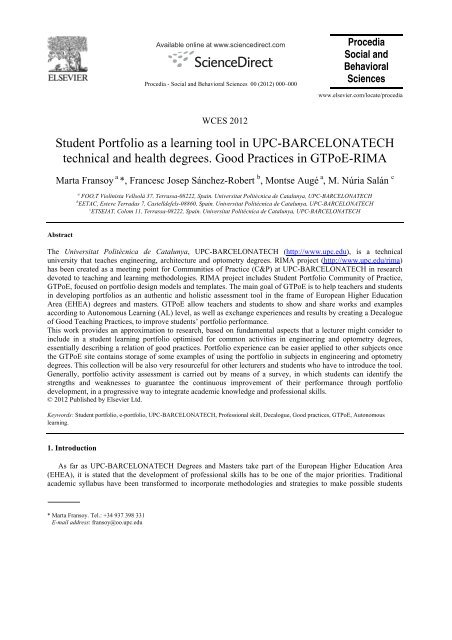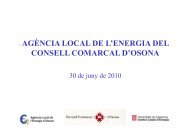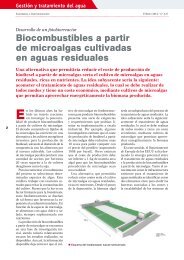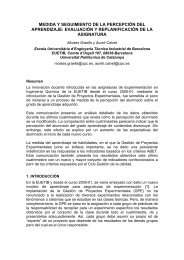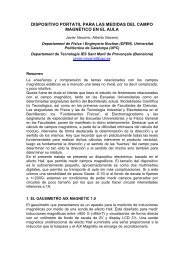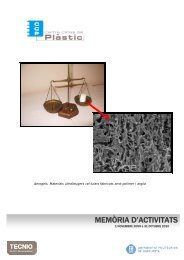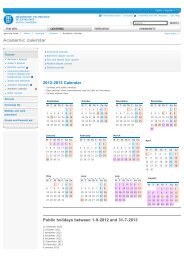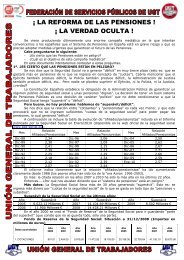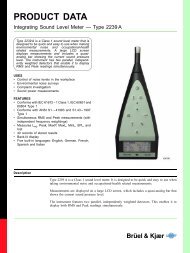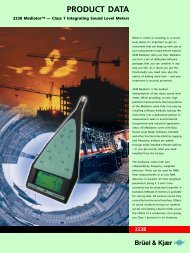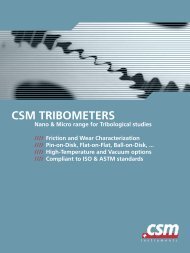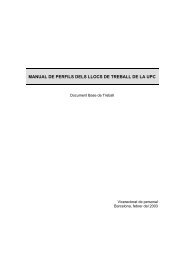Student Portfolio as a learning tool in UPC-BARCELONATECH ...
Student Portfolio as a learning tool in UPC-BARCELONATECH ...
Student Portfolio as a learning tool in UPC-BARCELONATECH ...
Create successful ePaper yourself
Turn your PDF publications into a flip-book with our unique Google optimized e-Paper software.
Available onl<strong>in</strong>e at www.sciencedirect.com<br />
Procedia - Social and Behavioral Sciences 00 (2012) 000–000<br />
Procedia<br />
Social and<br />
Behavioral<br />
Sciences<br />
www.elsevier.com/locate/procedia<br />
WCES 2012<br />
<strong>Student</strong> <strong>Portfolio</strong> <strong>as</strong> a <strong>learn<strong>in</strong>g</strong> <strong>tool</strong> <strong>in</strong> <strong>UPC</strong>-<strong>BARCELONATECH</strong><br />
technical and health degrees. Good Practices <strong>in</strong> GTPoE-RIMA<br />
Marta Fransoy a *, Francesc Josep Sánchez-Robert b , Montse Augé a , M. Núria Salán c<br />
a FOO,T Viol<strong>in</strong>ista Vellsolà 37, Terr<strong>as</strong>sa-08222, Spa<strong>in</strong>. Universitat Politècnica de Catalunya, <strong>UPC</strong>-<strong>BARCELONATECH</strong><br />
b EETAC, Esteve Terrad<strong>as</strong> 7, C<strong>as</strong>telldefels-08860, Spa<strong>in</strong>. Universitat Politècnica de Catalunya, <strong>UPC</strong>-<strong>BARCELONATECH</strong><br />
c ETSEIAT, Colom 11, Terr<strong>as</strong>sa-08222, Spa<strong>in</strong>. Universitat Politècnica de Catalunya, <strong>UPC</strong>-<strong>BARCELONATECH</strong><br />
Abstract<br />
The Universitat Politècnica de Catalunya, <strong>UPC</strong>-<strong>BARCELONATECH</strong> (http://www.upc.edu), is a technical<br />
university that teaches eng<strong>in</strong>eer<strong>in</strong>g, architecture and optometry degrees. RIMA project (http://www.upc.edu/rima)<br />
h<strong>as</strong> been created <strong>as</strong> a meet<strong>in</strong>g po<strong>in</strong>t for Communities of Practice (C&P) at <strong>UPC</strong>-<strong>BARCELONATECH</strong> <strong>in</strong> research<br />
devoted to teach<strong>in</strong>g and <strong>learn<strong>in</strong>g</strong> methodologies. RIMA project <strong>in</strong>cludes <strong>Student</strong> <strong>Portfolio</strong> Community of Practice,<br />
GTPoE, focused on portfolio design models and templates. The ma<strong>in</strong> goal of GTPoE is to help teachers and students<br />
<strong>in</strong> develop<strong>in</strong>g portfolios <strong>as</strong> an authentic and holistic <strong>as</strong>sessment <strong>tool</strong> <strong>in</strong> the frame of European Higher Education<br />
Area (EHEA) degrees and m<strong>as</strong>ters. GTPoE allow teachers and students to show and share works and examples<br />
accord<strong>in</strong>g to Autonomous Learn<strong>in</strong>g (AL) level, <strong>as</strong> well <strong>as</strong> exchange experiences and results by creat<strong>in</strong>g a Decalogue<br />
of Good Teach<strong>in</strong>g Practices, to improve students’ portfolio performance.<br />
This work provides an approximation to research, b<strong>as</strong>ed on fundamental <strong>as</strong>pects that a lecturer might consider to<br />
<strong>in</strong>clude <strong>in</strong> a student <strong>learn<strong>in</strong>g</strong> portfolio optimised for common activities <strong>in</strong> eng<strong>in</strong>eer<strong>in</strong>g and optometry degrees,<br />
essentially describ<strong>in</strong>g a relation of good practices. <strong>Portfolio</strong> experience can be e<strong>as</strong>ier applied to other subjects once<br />
the GTPoE site conta<strong>in</strong>s storage of some examples of us<strong>in</strong>g the portfolio <strong>in</strong> subjects <strong>in</strong> eng<strong>in</strong>eer<strong>in</strong>g and optometry<br />
degrees. This collection will be also very resourceful for other lecturers and students who have to <strong>in</strong>troduce the <strong>tool</strong>.<br />
Generally, portfolio activity <strong>as</strong>sessment is carried out by means of a survey, <strong>in</strong> which students can identify the<br />
strengths and weaknesses to guarantee the cont<strong>in</strong>uous improvement of their performance through portfolio<br />
development, <strong>in</strong> a progressive way to <strong>in</strong>tegrate academic knowledge and professional skills.<br />
© 2012 Published by Elsevier Ltd.<br />
Keywords: <strong>Student</strong> portfolio, e-portfolio, <strong>UPC</strong>-<strong>BARCELONATECH</strong>, Professional skill, Decalogue, Good practices, GTPoE, Autonomous<br />
<strong>learn<strong>in</strong>g</strong>.<br />
1. Introduction<br />
As far <strong>as</strong> <strong>UPC</strong>-<strong>BARCELONATECH</strong> Degrees and M<strong>as</strong>ters take part of the European Higher Education Area<br />
(EHEA), it is stated that the development of professional skills h<strong>as</strong> to be one of the major priorities. Traditional<br />
academic syllabus have been transformed to <strong>in</strong>corporate methodologies and strategies to make possible students<br />
* Marta Fransoy. Tel.: +34 937 398 331<br />
E-mail address: fransoy@oo.upc.edu
Marta Fransoy et al./ Procedia – Social and Behavioral Sciences 00 (2012) 000–000<br />
reach a level of maturity and proficiency, not only <strong>in</strong> the traditional read<strong>in</strong>g-writ<strong>in</strong>g-study<strong>in</strong>g-tak<strong>in</strong>g exams process,<br />
but also <strong>in</strong> develop<strong>in</strong>g protocols, skills and professional skills, <strong>in</strong>clud<strong>in</strong>g the widespread use of ICT (<strong>in</strong>formation and<br />
communication technologies) <strong>in</strong> every k<strong>in</strong>d of every day t<strong>as</strong>k rang<strong>in</strong>g from plann<strong>in</strong>g projects to f<strong>in</strong>al documentation<br />
and presentation. The adaptation to a more competent profile of studies h<strong>as</strong> been necessary <strong>in</strong> order to reduce the<br />
distance between professional requirements and profile of recent graduated students, who were fully academically<br />
prepared but not much skilled <strong>in</strong> the procedures and protocols required by their future profession, to a po<strong>in</strong>t that for<br />
them were not e<strong>as</strong>y to respond <strong>in</strong> a flexible way to the demands of career paths and future opportunities.<br />
To make the change possible, <strong>UPC</strong>-<strong>BARCELONATECH</strong> focused <strong>in</strong> seven generic skills to be added to the<br />
profile of all degrees, accord<strong>in</strong>gly to the official documental framework for the design and implementation of<br />
curricula degree [1]. Generic skills are transferable to a variety of functions and t<strong>as</strong>ks, and enable students to<br />
<strong>in</strong>tegrate successfully not only <strong>in</strong>to the profession but also <strong>in</strong>to social life. They are not thought to be exclusive of<br />
any professional specialty, but can be applied to a broad range of knowledge are<strong>as</strong>. The seven generic skills are:<br />
entrepreneurship and <strong>in</strong>novation, susta<strong>in</strong>ability and social commitment, third language, effective oral and written<br />
communication, team work, proper use of <strong>in</strong>formation resources, and autonomous <strong>learn<strong>in</strong>g</strong>. Plann<strong>in</strong>g of new degrees<br />
<strong>in</strong>cludes three important items: first: student-centered <strong>learn<strong>in</strong>g</strong>, second: goals accomplishment by means of skills<br />
and plann<strong>in</strong>g, and third: cont<strong>in</strong>uous evaluation and monitor<strong>in</strong>g of all teach<strong>in</strong>g activities us<strong>in</strong>g European Credit<br />
Transfer System ECTS criteria (http://www.ects.es).<br />
From this approach, the mission of the teacher is design<strong>in</strong>g activities, guid<strong>in</strong>g students <strong>in</strong> <strong>learn<strong>in</strong>g</strong>, plann<strong>in</strong>g and<br />
perform<strong>in</strong>g <strong>as</strong>sessment <strong>tool</strong>s and evaluation. <strong>Student</strong>s’ job is to perform activities planned, construct their self<strong>learn<strong>in</strong>g</strong><br />
and get engaged <strong>in</strong> it. The use of portfolio <strong>in</strong> higher education is a major way to transform the <strong>in</strong>teraction<br />
between student and teacher, for it motivates deep engagement of students <strong>in</strong> the <strong>learn<strong>in</strong>g</strong> process, <strong>in</strong>fus<strong>in</strong>g<br />
reflective practice and design<strong>in</strong>g different ways to <strong>as</strong>ses work and evaluate knowledge and skills <strong>in</strong> the professional<br />
area. This is a challenge, requires radical changes <strong>in</strong> practice. This is the aim of this paper, lead<strong>in</strong>g to writ<strong>in</strong>g a<br />
Decalogue of good practices <strong>in</strong> develop<strong>in</strong>g portfolios to be used <strong>as</strong> a guidel<strong>in</strong>e for implementation of skills <strong>in</strong><br />
technical and health university bachelor degrees and m<strong>as</strong>ters.<br />
GTPoE (Grup de Treball en el Portafoli de l’Estudiantat, http://www.upc.edu/rima/grups/gtpoe) is a community<br />
of practice (C of P) <strong>in</strong>cluded <strong>in</strong> a major RIMA project (Recerca i Innovació en Metodologies d'Aprenentatge,<br />
http://www.upc.edu/rima), a proposal from Education Science Institute (ICE, http://www.ice.upc.edu), a meet<strong>in</strong>g<br />
po<strong>in</strong>t for all the research groups of the <strong>UPC</strong>-<strong>BARCELONATECH</strong> <strong>in</strong> teach<strong>in</strong>g and <strong>learn<strong>in</strong>g</strong> <strong>in</strong>novation giv<strong>in</strong>g them<br />
visibility to their activities. By means of RIMA, GTPoE is the forum where teachers who are concerned <strong>in</strong> adapt<strong>in</strong>g<br />
their subjects to new trends <strong>in</strong> higher education implement<strong>in</strong>g the use of portfolio, can share their experiences and<br />
work together creat<strong>in</strong>g and carry<strong>in</strong>g out common projects, like the one presented <strong>in</strong> this paper [2].<br />
2. <strong>Student</strong> <strong>Portfolio</strong> <strong>as</strong> a teach<strong>in</strong>g-<strong>learn<strong>in</strong>g</strong> <strong>tool</strong><br />
<strong>Student</strong> portfolio is a collection of evidences of what h<strong>as</strong> been learned over a period of time, dur<strong>in</strong>g an academic<br />
period, <strong>in</strong> a specific subject, along with reflections and evaluations about the progress <strong>in</strong> <strong>learn<strong>in</strong>g</strong> done by students<br />
or cooperative groups of students, under the supervision of their <strong>in</strong>structor [3]. The collection of selected works<br />
(real-world artifacts) <strong>in</strong>cluded <strong>in</strong> the portfolio is dynamic and changes <strong>as</strong> the course develops and student matures <strong>in</strong><br />
the process. Depend<strong>in</strong>g on the objectives stated <strong>in</strong> common at the beg<strong>in</strong>n<strong>in</strong>g by teacher and student, portfolio may<br />
show the <strong>learn<strong>in</strong>g</strong> process (<strong>learn<strong>in</strong>g</strong> portfolio) [4] or the selection of the best work the student h<strong>as</strong> performed dur<strong>in</strong>g<br />
the year or through all the studies (showc<strong>as</strong>e portfolio) [5]. <strong>Portfolio</strong>s, thus, have the potential to make <strong>learn<strong>in</strong>g</strong><br />
concrete and visible, thereby provid<strong>in</strong>g faculty, future employers and students with the opportunity to focus on new<br />
ways of <strong>learn<strong>in</strong>g</strong> [6].<br />
Creat<strong>in</strong>g a portfolio is a mean<strong>in</strong>gful way to learn. It is an unbi<strong>as</strong>ed material evidence that student h<strong>as</strong> reached (or<br />
not) the goal proposed: to demonstrate his skills <strong>in</strong> a concrete subject, not only from an academic po<strong>in</strong>t of view, but<br />
also develop<strong>in</strong>g strategies <strong>in</strong> decision mak<strong>in</strong>g, and start<strong>in</strong>g to build a professional identity. The process of<br />
develop<strong>in</strong>g a portfolio is the best way to shift student from play<strong>in</strong>g a p<strong>as</strong>sive role <strong>in</strong> the <strong>learn<strong>in</strong>g</strong> process to an active<br />
role, <strong>in</strong>clud<strong>in</strong>g <strong>as</strong>sessment and evaluation (by means of agreed rubrics) because he must engage <strong>in</strong> more complex<br />
2
Author name / Procedia – Social and Behavioral Sciences 00 (2012) 000–000<br />
th<strong>in</strong>k<strong>in</strong>g and self-evaluation, to choose the best evidences (real-world artifacts) that demonstrate his skills.<br />
Develop<strong>in</strong>g a portfolio is a way to boost <strong>in</strong>teraction among teachers and learners. It h<strong>as</strong> been proved that clear goals,<br />
high standards and expectations raise the level of student performance. Know<strong>in</strong>g that student’s work h<strong>as</strong> to be public<br />
is a motivation that raises the level of duty and obligation of both students and teachers.<br />
When teacher and student agree <strong>in</strong> us<strong>in</strong>g portfolio <strong>as</strong> a <strong>learn<strong>in</strong>g</strong> and <strong>as</strong>sessment <strong>tool</strong>, they <strong>as</strong>sume some<br />
challenges: to work <strong>in</strong> a highly organized subject, requir<strong>in</strong>g a level of <strong>in</strong>volvement which is substantially higher<br />
than when study<strong>in</strong>g a conventional course b<strong>as</strong>ed on <strong>as</strong>sessment with multiple choice question or essays; the need of<br />
new organizational structures; a high commitment on the use of technology skills and <strong>tool</strong>s; more study time <strong>in</strong><br />
cl<strong>as</strong>s and out of cl<strong>as</strong>s; consensus upon rubrics to score <strong>as</strong>signments done; commitment <strong>in</strong> professional development;<br />
and some legal attributes like portfolio authorship. On the other hand, there are many benefits <strong>as</strong>sociated with the<br />
use of portfolio: student is the center of <strong>learn<strong>in</strong>g</strong> process, so it is necessary to use active <strong>learn<strong>in</strong>g</strong> techniques, <strong>as</strong><br />
cooperative <strong>learn<strong>in</strong>g</strong>, experimental c<strong>as</strong>e reports, problem-b<strong>as</strong>ed <strong>learn<strong>in</strong>g</strong>, discovery <strong>learn<strong>in</strong>g</strong>, and it makes e<strong>as</strong>ier the<br />
self-evaluation, peers-evaluation (also called co-evaluation), all of them activities <strong>as</strong>sociated with the higher<br />
cognitive level [7].<br />
2.1. Prepar<strong>in</strong>g a <strong>Portfolio</strong><br />
Decid<strong>in</strong>g to implement portfolio <strong>as</strong> a teach<strong>in</strong>g-<strong>learn<strong>in</strong>g</strong> <strong>tool</strong> <strong>in</strong> a course, implies a change of paradigm: from now<br />
on, student becomes the centre of <strong>learn<strong>in</strong>g</strong> process. This situation h<strong>as</strong> several implications that teacher h<strong>as</strong> to<br />
consider:<br />
The purpose of portfolio will determ<strong>in</strong>e its organization, content and presentation style. It is very different<br />
to conceive a portfolio to show the <strong>learn<strong>in</strong>g</strong> development <strong>in</strong> first course of a degree (formative), or a<br />
cl<strong>in</strong>ical portfolio to demonstrate participation <strong>in</strong> cl<strong>in</strong>ical practices (summative), or a showc<strong>as</strong>e portfolio to<br />
be presented to a hir<strong>in</strong>g agent (market<strong>in</strong>g portfolios).<br />
The level of teacher commitment and dedication, accord<strong>in</strong>g to Biggs [8].<br />
The level of student autonomy accord<strong>in</strong>g to the level of the course <strong>in</strong> the curriculum. <strong>UPC</strong>-<br />
<strong>BARCELONATECH</strong> takes <strong>as</strong> a reference the Bloom’s taxonomy of <strong>learn<strong>in</strong>g</strong> cognitive level hierarchy [9]<br />
and def<strong>in</strong>es three ma<strong>in</strong> levels. Table 1 shows the relationship between student level of autonomy and the<br />
suitable portfolio format accord<strong>in</strong>g to contents it h<strong>as</strong> to <strong>in</strong>clude.<br />
The nature of studies: <strong>in</strong> cl<strong>as</strong>sroom, blended or e-<strong>learn<strong>in</strong>g</strong> (at the <strong>UPC</strong>-<strong>BARCELONATECH</strong> by means of<br />
its Moodle-b<strong>as</strong>ed ATENEA platform).<br />
The level of technological complexity with which work h<strong>as</strong> to be performed [10,11].<br />
Table 1. Relationship between level of autonomous <strong>learn<strong>in</strong>g</strong> and portfolio format<br />
Autonomy<br />
Level<br />
Level 1:<br />
DIRECTED<br />
Level 2:<br />
GUIDED<br />
Level 3:<br />
AUTONOMOUS<br />
<strong>Student</strong> is able to Suitable <strong>in</strong> courses <strong>Portfolio</strong> format<br />
Make brief reports and production about what is learned. Follow<br />
timetable schedules rigorously. Follow strictly guidel<strong>in</strong>es on how<br />
to do t<strong>as</strong>ks. Work with <strong>in</strong>formation sources that teacher<br />
recommends or makes available <strong>as</strong> study materials.<br />
Write <strong>in</strong>dividual and group reports about what is learned and future<br />
actions proposals. Take decisions on the study time devoted to<br />
t<strong>as</strong>ks b<strong>as</strong>ed upon teacher orientations. Suggest improvements <strong>in</strong><br />
guidel<strong>in</strong>es on how to do t<strong>as</strong>ks. Add bibliographical references and<br />
other <strong>in</strong>formation sources b<strong>as</strong>ed on teacher suggestions.<br />
Analyze the accuracy and importance of topics <strong>in</strong> <strong>learn<strong>in</strong>g</strong> process<br />
and f<strong>in</strong>al knowledge. Decide time spent <strong>in</strong> <strong>learn<strong>in</strong>g</strong> content, and<br />
do<strong>in</strong>g the work. Decide how to do t<strong>as</strong>ks to perform <strong>as</strong> professional<br />
<strong>as</strong> possible. Decide to add other sources of <strong>in</strong>formation appropriate<br />
to meet the <strong>learn<strong>in</strong>g</strong> objectives.<br />
FIRST COURSE IN DEGREE<br />
SYLLABUS<br />
INTERMEDIATE COURSES<br />
LAST COURSE IN DEGREES.<br />
END-STUDIES PROJECT.<br />
PERSONAL PRESENTATION<br />
TO HIRING AGENTS<br />
Paper<br />
Moodle platform<br />
Paper<br />
Moodle platform<br />
Electronic support<br />
Moodle platform<br />
Electronic support:<br />
Videos, DVD,<br />
artefacts...<br />
web 2.0 for shar<strong>in</strong>g<br />
3
2.2. <strong>Portfolio</strong> contents. Good Practices<br />
Marta Fransoy et al./ Procedia – Social and Behavioral Sciences 00 (2012) 000–000<br />
As stated <strong>in</strong> the previous section, <strong>Portfolio</strong>’s contents are directly related to its purpose and context. We present<br />
here<strong>in</strong> the example of a summative portfolio, which is the most convenient to develop <strong>in</strong> first-<strong>in</strong>termediate-f<strong>in</strong>al<br />
years, and us<strong>in</strong>g a re<strong>as</strong>onably high technological level, <strong>in</strong>clud<strong>in</strong>g the option to elaborate an e-portfolio that can be<br />
shared <strong>in</strong> Moodle ATENEA Virtual Campus with the purpose of allow<strong>in</strong>g co-evaluation.<br />
0. Front page: Show<strong>in</strong>g a corporative image, subject title, date of presentation, student and teacher names, etc.<br />
1. Personal presentation: First page can be written <strong>as</strong> if it h<strong>as</strong> to be a blog profile, conta<strong>in</strong><strong>in</strong>g <strong>in</strong>formation<br />
about student. It is important to focus a paragraph on concerns and projects about studies, specialization<br />
area, and professional profile chosen concern<strong>in</strong>g what student <strong>as</strong>pires to carry on after graduation).<br />
2. Initial reflection: To place student <strong>in</strong> perspective, the second page of portfolio will conta<strong>in</strong> this rationale<br />
(about studies and about professional profile).<br />
3. It is appropriate that the third page of the portfolio conta<strong>in</strong>s the <strong>in</strong>dex, to e<strong>as</strong>ily f<strong>in</strong>d sections, exercises,<br />
artifacts placed <strong>in</strong> it. The <strong>in</strong>dex should be an exhaustive guide of the work presented.<br />
4. On the fourth portfolio page, the teach<strong>in</strong>g guide (Virtual Campus) h<strong>as</strong> to be placed, <strong>in</strong>clud<strong>in</strong>g <strong>as</strong>sessment<br />
and evaluation criteria, and time plann<strong>in</strong>g. It is necessary to keep our goals <strong>in</strong> m<strong>in</strong>d at any time.<br />
5. “Weekly time control templates” (Virtual Campus) are designed to help student to have an exact idea about<br />
time devoted to the subject, <strong>in</strong> and out of cl<strong>as</strong>sroom. Time spent, suggested articles to read, activities<br />
carried out by self-<strong>in</strong>itiative or planned by teacher. <strong>Student</strong>s can also present a real c<strong>as</strong>e <strong>in</strong> which they have<br />
participated <strong>in</strong> his company and which is related to the topic developed <strong>in</strong> cl<strong>as</strong>sroom that week. This<br />
activity can be recorded <strong>as</strong> time devoted to the subject, and may be <strong>as</strong>sessed positively when evaluat<strong>in</strong>g the<br />
competence autonomous <strong>learn<strong>in</strong>g</strong>. These “weekly time control templates” are accompanied by “t<strong>as</strong>k report<br />
templates” that have to be <strong>in</strong>cluded <strong>in</strong> the portfolio to summarize all k<strong>in</strong>d of complementary activities the<br />
student carries out that week.<br />
6. Initial <strong>as</strong>sessment: This is an estimation of the start<strong>in</strong>g level of student’s subject knowledge. Teacher may<br />
<strong>as</strong>k students to do some k<strong>in</strong>d of activity, a t<strong>as</strong>k to be solved and delivered through virtual campus once<br />
<strong>as</strong>sessed and handed <strong>in</strong> before the due date.<br />
7. Evidences and artefacts: It is necessary to hand <strong>in</strong> evidences of every unwritten t<strong>as</strong>k performed, particularly<br />
<strong>in</strong> onl<strong>in</strong>e courses. Material can be multimedia, pictures of the activity done, the diptych of a conference that<br />
w<strong>as</strong> attended, etc. If it is an artefact that h<strong>as</strong> been manufactured, pictures or videos are suitable.<br />
8. Documentation provided by own <strong>in</strong>itiative: Sometimes, students search <strong>in</strong>formation far beyond what is<br />
expected by the teacher. In this c<strong>as</strong>e, they are <strong>as</strong>ked to add a report reflect<strong>in</strong>g: Why they were <strong>in</strong>terested <strong>in</strong><br />
further <strong>in</strong>formation? What w<strong>as</strong> the issue that captured their attention? How it relates to the topic presented<br />
<strong>in</strong> cl<strong>as</strong>sroom, etc.<br />
9. Assessment: A midterm of f<strong>in</strong>al evaluation is considered, also a proposal for improvement.<br />
10. L<strong>as</strong>t page of the portfolio <strong>in</strong>cludes a f<strong>in</strong>al reflection and a survey of the subject, allow<strong>in</strong>g teachers to<br />
undertake improvements <strong>in</strong> future courses.<br />
3. <strong>Portfolio</strong> <strong>as</strong>sessment and evaluation<br />
The rubric we present here<strong>in</strong> (see Table 2) can be used to score portfolio <strong>in</strong> a holistic way, to <strong>as</strong>sess the<br />
completeness of the contents tak<strong>in</strong>g <strong>in</strong>to account all previous and partial scor<strong>in</strong>gs of particular t<strong>as</strong>ks and artefacts<br />
presented dur<strong>in</strong>g the course. It were designed by a group of lecturers at the <strong>UPC</strong>-<strong>BARCELONATECH</strong> [12].<br />
4. Conclusions and future l<strong>in</strong>es<br />
In this paper, we have presented the requirements to develop a student portfolio tak<strong>in</strong>g <strong>in</strong>to account its purpose<br />
and all the contextual conditions, which also can be used <strong>as</strong> a reference for teachers who want to implement this<br />
<strong>tool</strong> <strong>in</strong> their courses and share the experience <strong>in</strong> GTPoE Community of Practice. The aim is to create rubrics and<br />
4
Author name / Procedia – Social and Behavioral Sciences 00 (2012) 000–000<br />
templates, consider<strong>in</strong>g the particular needs of each degree at the <strong>UPC</strong> and to spread the use of the portfolio <strong>in</strong> our<br />
university. In a f<strong>in</strong>al ph<strong>as</strong>e, we aim to present the result of this cooperative research<br />
Table 2. Relationship between level of autonomous <strong>learn<strong>in</strong>g</strong> and portfolio format<br />
QUALITY CRITERIA FOR STUDENT’S PORTFOLIO<br />
CRITERION VERY GOOD TO IMPROVE INSUFFICIENT<br />
Schedule<br />
implementation<br />
Writ<strong>in</strong>g style<br />
Description of<br />
<strong>learn<strong>in</strong>g</strong><br />
Improvement<br />
goals<br />
Evidences<br />
References<br />
<strong>Student</strong> h<strong>as</strong> given different<br />
versions of the portfolio accord<strong>in</strong>g<br />
to schedule, also co-evaluation<br />
activities handed <strong>in</strong>.<br />
Phr<strong>as</strong>e length at about 2-3 l<strong>in</strong>es.<br />
Well-used punctuation marks help<br />
to understand the phr<strong>as</strong>e without<br />
any difficulty. Ide<strong>as</strong> are connected<br />
with each other. Text does not<br />
present misspell<strong>in</strong>g. It presents<br />
consistency <strong>in</strong> tense and the verb<br />
form is active.<br />
Text clearly describes <strong>learn<strong>in</strong>g</strong><br />
and improvements <strong>in</strong> each of the<br />
skills.<br />
Improvement targets for each of<br />
the skills are clear and concrete<br />
and re<strong>as</strong>onable goals are exposed.<br />
Evidences provided for each skills<br />
are a good example of what h<strong>as</strong><br />
been learned or improved.<br />
<strong>Student</strong> handed <strong>in</strong> some portfolio<br />
version or some peer coevaluation<br />
later than scheduled .<br />
Some sentences exceed the<br />
recommended length (2-3 l<strong>in</strong>es),<br />
although the punctuation marks<br />
help to understand the sentence<br />
without any difficulty. Some ide<strong>as</strong><br />
appear disconnected from others.<br />
Present tense consistency,<br />
although sentences are p<strong>as</strong>sive.<br />
Text h<strong>as</strong> no misspell<strong>in</strong>g.<br />
In some c<strong>as</strong>es text does not clearly<br />
describe what h<strong>as</strong> been learned or<br />
improved related to a certa<strong>in</strong><br />
competence.<br />
Expla<strong>in</strong>s the weaknesses <strong>in</strong> their<br />
<strong>learn<strong>in</strong>g</strong>, but does not specify<br />
what needs to improve. Terms do<br />
not appear <strong>in</strong> improvement plan.<br />
In some c<strong>as</strong>es, there is no clear<br />
relationship between provided<br />
evidence and described<br />
improvements.<br />
<strong>Student</strong> h<strong>as</strong> not handed <strong>in</strong> any of<br />
the versions of the portfolio or<br />
peer co-evaluation.<br />
Predom<strong>in</strong>ant long sentences and<br />
poorly constructed. Do not use<br />
punctuation correctly (po<strong>in</strong>ts<br />
replacement comma or<br />
semicolon). Change the tense<br />
without any justification (from<br />
p<strong>as</strong>t to future, for example).<br />
Phr<strong>as</strong>es appear with the verb <strong>in</strong><br />
p<strong>as</strong>sive participle. The text<br />
presents misspell<strong>in</strong>gs<br />
Text simply describes what have<br />
been made, but does not describe<br />
what student learned or improved<br />
related to evaluated skills.<br />
It does not <strong>in</strong>dicate what<br />
improvement targets are,<br />
Provided evidences not related<br />
with described improvements.<br />
[1] Consell de Govern de la <strong>UPC</strong>. Marc per al disseny i la implantació dels plans d'estudis de grau a la <strong>UPC</strong>. Acord número 38/2008, de 9<br />
d'abril, del Consell de Govern. Barcelona.<br />
[2] Aproximació al disseny de titulacions b<strong>as</strong>at en competències. Institut de Ciències de l'Educació <strong>UPC</strong>, 2008. Barcelona (http://wwwice.upc.edu/documents/eees/disseny_titulacions_competencies.pdf).<br />
[3] Monogràfics: El portafoli de l’estudiantat. Institut de Ciències de l’Educació <strong>UPC</strong>, 2010, Barcelona<br />
[4] Barrett, H Balanc<strong>in</strong>g the two faces of the eportfolio. http://electronicportfolios.com (l<strong>as</strong>t consultation: November 2011)<br />
[5] Valero, M., Rubio, J., Sánchez, F. J., Introduc<strong>in</strong>g the student competency portfolio <strong>in</strong> the C<strong>as</strong>telldefels School of Technology (EPSC), E-<br />
<strong>Portfolio</strong> Conference, Ma<strong>as</strong>tricht, Holland, 2007<br />
[6] Johnson, R.S.; Mims-Cox J.S.; Oyle- Nichols, A. Develop<strong>in</strong>g portfolios <strong>in</strong> Education. A guide to reflection, <strong>in</strong>quiry and <strong>as</strong>sessment.. 2 nd<br />
ed. Sage. California 2010<br />
[7] Krathwohl, D.R.; Anderson, L.W Taxonomy for <strong>learn<strong>in</strong>g</strong>,teach<strong>in</strong>g and <strong>as</strong>sess<strong>in</strong>g: A revision of Bloom’s taxonomy of educational<br />
objectives. Ed. Pearson, London 2001<br />
[8] Biggs, J. Teach<strong>in</strong>g for Quality Learn<strong>in</strong>g at University.SHRE, Open University Press,1999., http://www.engsc.ac.uk/er/theory/ (l<strong>as</strong>t<br />
consultation: November 2011)<br />
[9] https://www.upc.edu/eees/disseny_<strong>as</strong>signatures/guia-docent/copy2_of_els-objectius (l<strong>as</strong>t consultation: november 2011)<br />
[10] Wyatt III, R.L.; Looper, S. So You Have to Have a <strong>Portfolio</strong>: A teacher’s Guide to Preparation and Presentation. 2ª ed. Corw<strong>in</strong> Press,<br />
California 2004<br />
[11] Barret,H Electronic <strong>Portfolio</strong>s. [on-l<strong>in</strong>e] http://electronicportfolios.com (l<strong>as</strong>t consultation: November 2011)<br />
[12] Armengol,J. Hernández J., Mora J, Rubio J,Sànchez F.,Valero M. Experienci<strong>as</strong> sobre el uso del portafolio del estudiante en la <strong>UPC</strong>.<br />
Revista de docència Universitària, III, Monogràfic III (June 2009), http://www.um.es/ead/Red_U/m3/ (l<strong>as</strong>t consultation: september 2011).<br />
5


